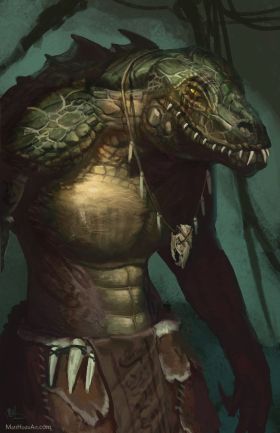Lizardfolk
| Species | humanoid (reptiloid) |
| No. Appearing | 2–20 |
| Behaviour | clan |
| Range | coral reef, intertidal, jungle, rainforest, savanna |
| Size | 7 ft. tall |
| Weight | 320 lbs. |
| Intelligence | 7–8 |
| Armour Class | 4 |
| Hit Dice | 2+1 |
| Action Points | 5 |
| Max. Stride | 8 |
| THAC0 | 20 |
| Hp/Die | 2d4 |
| Attack Forms | 3 or 2: two claws and fangs, or claw and weapon type |
| Damage | 1–4/1–4 & 2–8 |
| Special Attacks | strength (18) |
Lizard men are cold-blooded humanoids that dwell in the tropics of the New World, from the Yucatan peninsula to the Parana basin. Typically around 6 to 7 feet tall with thick, scaly skin that resembles that of a lizard or crocodile, these creatures are formidable opponents, using their brute strength and proficiency in melee combat to overpower adversaries. They're known for their ambush tactics, often using their natural environment to their advantage.
Contents
Well-known to be violent towards outsiders, lizardfolk have a taste for other humanoid flesh and can live upon only meat for weeks at a time. There are many stories of humans being collected and held captive for months, readied for shamanistic ritual feasts involving multiple tribes that gather together.
History
Created as guardians of Olmec culture through the divine intervention of the god Xitlanacoatl, whose spirit combined the concepts of vitality and reptilian symbolism, the first lizardfolk came into existence about 2000 BC. Thereafter they served as guardians of the human culture that flourished in what is now present-day Mexico, particularly in the Gulf coast region.
As the lizardfolk increased in number they grew increasingly independent, migrating southward into the jungles of Central America, the Cordillera and the Amazon basin, where small, independent reptilian societies were founded. The original lizardfolk turned against their Olmec masters, contributing to the destruction of that culture; afterwards, many wars would be waged between the Mayans and the Aztecs against lizardfolk — who now contend to some degree against the newly arrived Europeans.
Behaviour
Organised lizardfolk societies reach the level of city-states, each ruled by a council of shamans and warrior chiefs. Each city rules over a large, empty territory of jungle, savanna or deserted coastline, traditionally a hundred miles wide. This kept in a wilderness state by the lizardfolk themselves, who slaughter any who attempt to settle there — including factions from the city-state itself whose attempts to found new colonies are discouraged. The social structure is highly competitive and violent, with the inhabitants indulging in bloodsports and ritual sacrifice of the weak or of unwanted offspring.
Lizardfolk have an advanced understanding of agriculture, employing sophisticated irrigation systems to cultivate crops, and have developed a rudimentary but advanced understanding of engineering and craftsmanship. They construct massive stone temples and pyramids at the heart of their cities, using their adeptness with stonework to create awe-inspiring structures. The culture is rich in art, with intricate stone carvings and sculptures depicting their deities and legendary heroes. They possess a complex calendar system based on celestial events and maintain a pantheon of nature-focused gods, honoring the cycles of the sun, moon and rain.
Organisation
Commoner lizardfolk live in crude huts surrounding the central stone-built city, tending to fight with only their claws and fangs. The more elite combatants are trained in the macuahuitl, a vicious hacking weapon fashioned of wood and embedded obsidian stones; these cause 2-8 damage when they hit. Shields aren't used. The elite wear leather armour in war or when participating in ritual combat, but never otherwise.
Advantages
18 strength: Due to their natural size and strength, lizardfolk receive a +1 bonus to hit opponents, with a +2 bonus to damage caused when using weapons in melee.
See Bestiary
